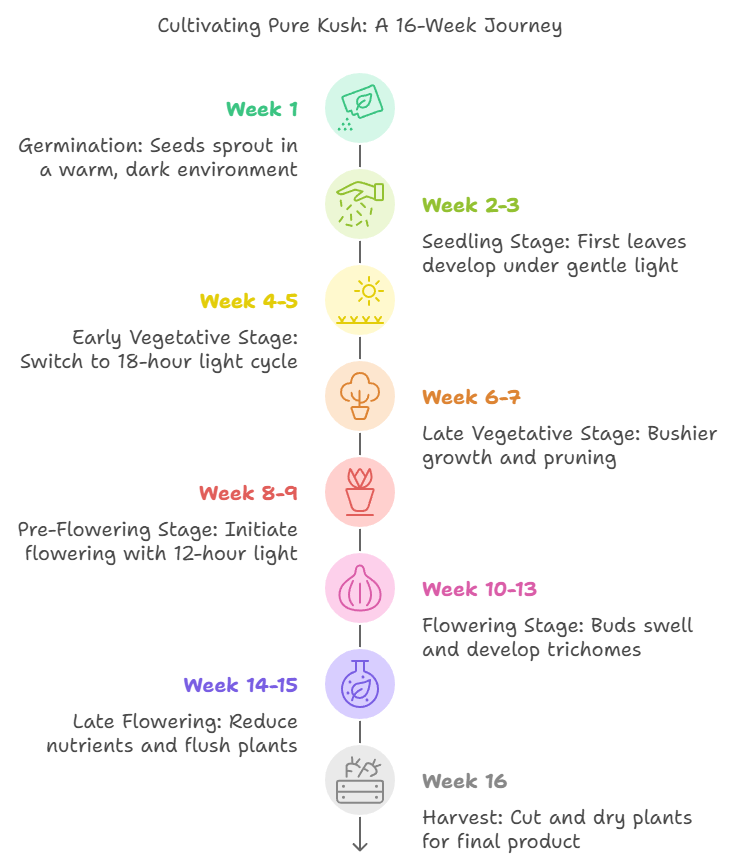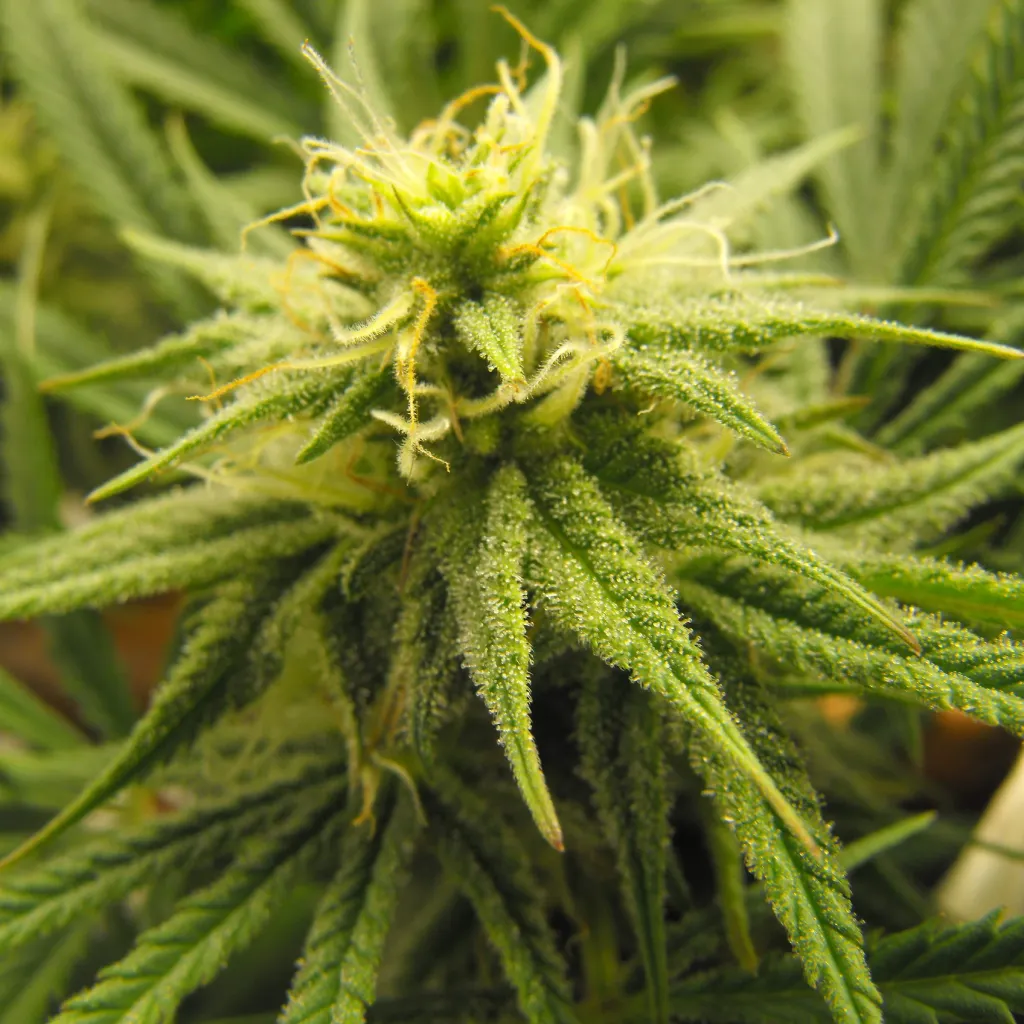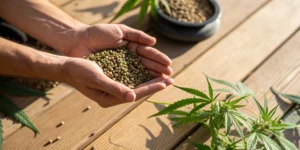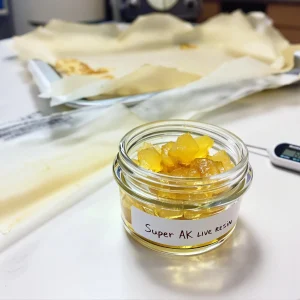Pure Kush strain is a powerful indica-dominant variety that has captured the hearts of cannabis enthusiasts. Its dense buds, vibrant orange pistils, and heavy coating of resin are a visual delight. Known for its earthy, pine-like aroma combined with undertones of sweetness, it delivers a relaxing, body-heavy effect, perfect for unwinding after a long day. The Pure Kush strain typically boasts a THC content ranging from 18% to 22%, making it a favorite for those seeking relief from stress and physical discomfort.
With its heavy indica profile, Pure Kush offers a deep body relaxation that borders on couch-lock, making it ideal for evening use. Whether you’re cultivating it for its medicinal benefits or simply for its classic cannabis experience, Pure Kush delivers a consistent and powerful impact. Growers appreciate its resilience and the rich terpene profile that delivers flavors of earth, spice, and a hint of fruitiness.
Environmental Requirements for Growing Pure Kush Strain
To achieve the best results with the Pure Kush strain, it is important to provide an environment that caters to its needs. This strain thrives in temperatures between 70-80°F (21-27°C) during the day and a slightly cooler climate at night. Maintaining a relative humidity (RH) between 40-50% during the vegetative stage and reducing it to around 30-40% during flowering helps prevent mold and mildew, which can be problematic for dense buds like those of Pure Kush.
Lighting is also a key factor. For indoor growth, full-spectrum LED lights or high-pressure sodium (HPS) lamps are recommended to simulate natural sunlight and help the plant achieve its full potential. Proper air circulation is equally essential for the Pure Kush strain, as it reduces the risk of mold and pests. Using fans to circulate air throughout the grow space will help keep the conditions optimal.
Setting Up The Growing Cannabis Space
Setting up the right growing environment is crucial for cultivating the Pure Kush strain. For indoor cultivation, a grow tent is ideal to help control environmental conditions. Choose a tent that accommodates the number of plants you plan to grow, while ensuring enough space for air circulation and maintenance. Line the interior with reflective material to maximize the efficiency of your grow lights.
For soil, opt for a well-draining, organic mix rich in nutrients. Pure Kush does well with soil that has added perlite or coco coir to improve aeration. Hydroponic setups can also be used, though beginners might find soil cultivation more forgiving. Maintaining a pH level between 6.0 and 6.5 is ideal to ensure the roots can absorb nutrients effectively.
Indoor Cannabis Cultivation
Indoor cultivation of Pure Kush strain provides control over all aspects of the growth process. Start by placing your plants under LED lights that deliver around 18 hours of light per day during the vegetative stage. Keeping light intensity high encourages healthy, vigorous growth. Pure Kush plants can grow bushy, so pruning lower leaves and branches will allow better airflow and light penetration to the middle and lower sections of the plant.
Training techniques like topping and low-stress training (LST) are particularly useful for indoor growers. Topping will encourage the plant to grow multiple main colas, while LST helps in spreading out the branches for even light distribution. Keeping temperatures consistent and ensuring good air exchange will promote the health of your plants and the quality of the final harvest.
Outdoor Cannabis Cultivation
The Pure Kush strain can also thrive outdoors, especially in climates that mimic the Mediterranean. Choose a location with plenty of direct sunlight, at least 6-8 hours per day. Plant your Pure Kush in nutrient-rich, well-drained soil, and monitor the weather closely. These plants are resilient, but heavy rainfall can be detrimental during the flowering phase, increasing the risk of mold.
Outdoor cultivation allows the Pure Kush strain to reach its full potential in terms of size, often leading to greater yields. However, outdoor growers must be vigilant for pests and changes in weather. Staking plants can help support heavy branches and protect them from strong winds. Pure Kush can be ready for harvest by mid-October, with outdoor plants yielding substantial amounts under ideal conditions.
Propagation and Germination of Pure Kush Strain
Starting with quality seeds or clones is essential for cultivating Pure Kush strain successfully. To germinate seeds, use the paper towel method, place the seeds between moist paper towels in a warm, dark place for a few days until they sprout taproots. Once the roots emerge, transfer the seeds to their initial growing medium, such as small pots with seed-starting soil.
For those using clones, ensure they are healthy, with no signs of disease or pests. Place them in a rooting medium until they establish roots, typically within 7-10 days. Providing gentle light and keeping humidity high during this stage will help the young plants thrive. A humidity dome can be very beneficial to maintain the right level of moisture.
Vegetative Phase of Pure Kush Strain
During the vegetative phase, Pure Kush strain plants focus on developing strong branches and lush foliage. This stage typically lasts between 4-8 weeks, depending on your grow setup and how large you want the plants to be. The vegetative phase requires a light schedule of 18 hours on and 6 hours off to encourage robust growth.
It is important to feed the plants with nitrogen-rich nutrients during this stage, as nitrogen supports leaf and stem development. Regularly checking the pH levels of the water and soil ensures that nutrients are effectively absorbed. Pruning excess leaves and using techniques like topping can help the plant grow bushier, leading to better light penetration and increased yields.
Flowering Phase of Pure Kush Strain
The flowering phase is when the Pure Kush strain starts forming its famous dense buds. This phase usually takes around 8-9 weeks to complete. To trigger flowering, change the light schedule to 12 hours of light and 12 hours of darkness. This reduction in light mimics the natural transition from summer to fall, prompting the plant to flower.
During flowering, phosphorus and potassium become more important for bud development. Switching to a bloom-specific fertilizer will support the plant in producing bigger, resin-rich buds. It’s also essential to reduce humidity to around 30-40% during this phase to prevent mold. Keep an eye out for any signs of nutrient deficiency, pests, or environmental stress, as they can negatively impact bud quality.
Cannabis Fertilization and Nutrition
The Pure Kush strain requires balanced fertilization to achieve optimal growth. During the vegetative phase, feed your plants with a nitrogen-heavy fertilizer to promote healthy growth. As they move into the flowering stage, shift to a fertilizer high in phosphorus and potassium, which are crucial for bud formation.
Nutrient deficiencies can be a common problem for many growers. Yellowing leaves may indicate a lack of nitrogen, while poor bud development could mean insufficient phosphorus. Always monitor the pH of your growing medium, as nutrient lockout can occur if levels are too far outside the ideal range. Regularly flushing the growing medium with plain water helps prevent the build-up of excess nutrients.
Pest and Disease Control for Cannabis Growing
Growing Pure Kush strain successfully involves managing pests and preventing diseases. Pests like spider mites, aphids, and whiteflies can be problematic, especially in warmer environments. Using organic pest control methods, such as insecticidal soap or neem oil, can help keep these pests at bay without harming the plant.
Mold and mildew are potential problems for Pure Kush, particularly during the flowering phase. Good airflow and reduced humidity are key preventative measures. Removing dead leaves and branches will help prevent mold spores from taking hold. Regular inspection of your plants will allow you to catch early signs of disease or infestation before they become significant problems.
Prevention
Preventing pests and disease begins with maintaining a clean grow environment. Disinfect tools and equipment regularly, and avoid over-watering, which can create the perfect environment for fungi and mold. Healthy plants are less susceptible to infestations, so ensuring your plants are well-fed and not stressed is a key preventive measure.
Companion planting is another effective way to prevent pests. Growing herbs like basil, mint, or marigold alongside your Pure Kush strain can help repel harmful insects naturally. Encouraging beneficial insects like ladybugs in your garden can also keep pest populations under control.
Corrective Actions
If pests or disease appear, act quickly to mitigate damage. Manually remove visible insects and use organic sprays for control. In cases of mold, remove affected areas immediately and adjust environmental factors, like lowering humidity and increasing airflow. If nutrient deficiencies occur, adjust feeding schedules and consider adding supplements.
Neem oil and insecticidal soaps can be effective solutions, but be cautious about their application during the flowering stage to avoid residue on buds. Sticky traps are also useful for controlling flying pests without using chemicals.
Harvesting and Curing for Cannabis Growing
Harvesting Pure Kush strain at the right time is crucial for obtaining the highest potency and best flavor. Generally, Pure Kush is ready for harvest after 8-9 weeks of flowering, once the trichomes turn a milky white color, with some amber hues indicating peak THC levels. Harvesting too early can result in reduced potency, while waiting too long can lead to degraded cannabinoids.
After harvesting, trimming the buds and curing them properly is essential for maximizing the flavor and potency of the Pure Kush strain. Dry the trimmed buds in a cool, dark place with plenty of airflow for about 7-10 days. Once dry, cure the buds by placing them in airtight jars, opening them daily for the first week to allow moisture to escape. This process should last 2-4 weeks to fully develop the strain’s complex terpene profile.
Is Pure Kush Strain Indica or Sativa?
It is a true indica-dominant variety. It is known for its sedative effects, making it ideal for evening use or when deep relaxation is desired. With strong body effects, it’s commonly used for stress relief, pain management, and insomnia. Its heavy indica lineage provides a powerful couch-lock effect, making it less suitable for daytime activities.
This strain’s genetic background contributes to its distinctive characteristics, from its compact plant structure to its potent effects. Pure Kush’s indica traits make it a popular choice for those who prefer a full-body experience, making it a favorite among medicinal and recreational users alike.
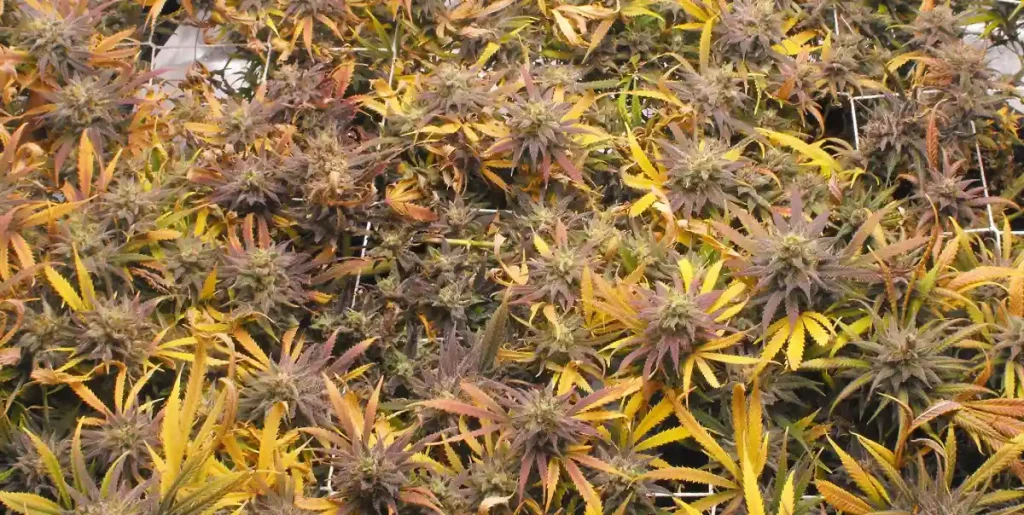
Advantages of Growing Pure Kush Strain
Pure Kush strain offers several benefits for growers. One of the most significant advantages is its resilience. This strain can handle a variety of growing conditions, making it suitable for both indoor and outdoor cultivation. Its natural resistance to many common pests and molds also makes it a relatively low-maintenance option.
Another advantage is the high yield potential of Pure Kush. When grown under optimal conditions, it can produce dense, resinous buds that are perfect for both personal use and commercial purposes. The heavy resin production also makes this strain ideal for extracts and concentrates, adding versatility to its cultivation benefits.
Disadvantages of Growing Pure Kush Strain
Despite its many strengths, there are some challenges associated with growing Pure Kush strain. One downside is its susceptibility to mold, especially in humid environments. Growers must be vigilant in monitoring humidity levels, particularly during the flowering phase, to prevent mold from affecting the buds.
Another potential disadvantage is the strain’s relatively long flowering period. While 8-9 weeks is not excessively long, it can be an obstacle for growers looking for a quick turnaround. However, the results are well worth the wait, as the final product delivers both in quality and quantity.
Problems in Cultivating Pure Kush Strain
Cultivating Pure Kush strain can come with its set of challenges. Issues like nutrient deficiencies can arise, especially if the pH levels are not well managed. Regular monitoring of soil and water pH is essential to prevent nutrient lockout and ensure healthy plant growth.
Pests like spider mites can also become an issue, especially in indoor grows where conditions can be perfect for their reproduction. Proper airflow and organic pest management are key to keeping these problems at bay. Additionally, over-watering can lead to root rot, which is particularly dangerous for Pure Kush due to its dense bud structure.
Advanced Pest Control for Cannabis Growing
For experienced growers cultivating Pure Kush strain, advanced pest control methods may be necessary. Integrated Pest Management (IPM) combines biological, cultural, and chemical tools to manage pests effectively without harming the plant or the environment. Introducing predatory insects like ladybugs or lacewings can naturally keep pest populations in check.
Using beneficial fungi like Trichoderma can protect the plant roots from pathogens, reducing the likelihood of root rot. Advanced pest control also involves consistently monitoring the plant environment and adjusting humidity, temperature, and light to prevent infestations before they take hold. Early intervention is key to maintaining plant health and maximizing yields.
Week-by-Week Growth Plan for Pure Kush Strain
Week 1: Germination
During the first week, germinate your seeds using the paper towel method. Maintain humidity around 70% and keep seeds in a dark, warm environment. Once taproots appear, plant them in seed-starting soil or a small pot.
Week 2-3: Seedling Stage
The seedlings will begin to develop their first leaves. Keep the humidity high at 60-70% and use a light source that isn’t too strong to avoid burning the young plants. Keep temperatures between 70-75°F (21-24°C).
Week 4-5: Early Vegetative Stage
During these weeks, switch to an 18-hour light cycle and begin feeding with a mild nutrient solution rich in nitrogen. Keep humidity around 50-60% to support leaf growth. Start using low-stress training techniques if desired.
Week 6-7: Late Vegetative Stage
This plants will now be bushier. Increase the light intensity and continue feeding with a balanced nutrient solution. Prune lower branches to improve airflow and light penetration.
Week 8-9: Pre-Flowering Stage
Switch to a 12-hour light cycle to initiate flowering. The plants will stretch during these weeks, and you’ll see the first signs of bud development. Reduce humidity to 40-50% and feed with a bloom-specific fertilizer.
Week 10-13: Flowering Stage
Buds will start to swell and develop more trichomes. Keep feeding with bloom nutrients and ensure humidity stays low to avoid mold. Temperatures should remain between 68-75°F (20-24°C).
Week 14-15: Late Flowering
In these weeks, focus on reducing nutrients to flush the plants. This helps to improve the flavor of the final product. Keep an eye on trichomes for ripeness, a mix of milky and some amber trichomes indicates readiness for harvest.
Week 16: Harvest
Harvest your plants when the trichomes are at their peak. Cut the branches and begin the drying process. Maintain good airflow in the drying area, and aim for a slow, even dry over 7-10 days.
This week-by-week growth timeline provided is an estimate. Actual growth times may vary based on environmental factors such as climate and growing conditions.
FAQs About Pure Kush Strain
What is the THC percentage of Pure Kush strain?
Pure Kush typically contains THC levels ranging from 18% to 22%, delivering a potent and deeply relaxing experience. This moderate-to-high potency makes it suitable for both medicinal and recreational users seeking relief from stress, pain, or insomnia. The balanced THC content ensures a strong effect without overwhelming newer users, though caution is still advised for those with low tolerance. Its potency also makes it a favorite among experienced consumers looking for a consistent and calming high.
How long does it take for Pure Kush to flower?
Pure Kush generally flowers in 8 to 9 weeks when grown under optimal conditions. Indoor growers can expect precise results by maintaining consistent light schedules and humidity levels, while outdoor cultivation may vary depending on the local climate. Proper care during the flowering phase, such as using phosphorus-rich nutrients and ensuring proper airflow, can maximize bud density and resin production. The relatively short flowering period makes Pure Kush an attractive choice for growers seeking a quicker turnaround.
What flavors and terpenes are present in Pure Kush strain?
Pure Kush boasts a rich flavor profile characterized by earthy, pine, and slightly fruity notes. These flavors are driven by a terpene blend that includes myrcene, known for its relaxing and sedative effects; caryophyllene, which adds a peppery kick and potential anti-inflammatory benefits; and limonene, contributing subtle citrus undertones that uplift the overall aroma. This combination makes Pure Kush a flavorful and aromatic choice for connoisseurs who value complex taste profiles alongside potent effects.
